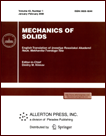 | | Mechanics of Solids
A Journal of Russian Academy of Sciences | | Founded
in January 1966
Issued 6 times a year
Print ISSN 0025-6544
Online ISSN 1934-7936 |
Archive of Issues
| Total articles in the database: | | 13362 |
| In Russian (»Á‚. –ņÕ. Ő““): | | 8178
|
| In English (Mech. Solids): | | 5184 |
|
| << Previous article | Volume 59, Issue 6 / 2024 | Next article >> |
| Huimei Zhang, Susu Chen, and Shiguan Chen, "Dynamic Mechanical Characteristics and Damage Modeling of Freeze-thawed Red Sandstone," Mech. Solids. 59 (6), 3464-3480 (2024) |
| Year |
2024 |
Volume |
59 |
Number |
6 |
Pages |
3464-3480 |
| DOI |
10.1134/S0025654424604580 |
| Title |
Dynamic Mechanical Characteristics and Damage Modeling of Freeze-thawed Red Sandstone |
| Author(s) |
Huimei Zhang (College of Science, Xiían University of Science and Technology, Xiían, 710054 China)
Susu Chen (College of Science, Xiían University of Science and Technology, Xiían, 710054 China, 22201106042@stu.xust.edu.cn)
Shiguan Chen (College of Architecture and Civil Engineering, Xiían University of Science and Technology, Xiían, 710054 China) |
| Abstract |
To research the damage variations and dynamic mechanical attributes of freeze-thawed
rocks, freeze-thaw cycle and impact dynamic compression experiments were performed on samples of
water-saturated red sandstone and built the dynamic constitutive model of the entire freeze-thawed
rock process by using the theory of the combined model of elements and investigating the rule of damage evolution. According to the findings, the rock specimensí dynamic peak stress and elastic modulus
are enhanced with a rise in strain rate, while these properties are reduced with an increase in freeze-thaw cycles. The experimental and theoretical curves agree, with a goodness of fit of up to 0.9457.
There are three stages in a rockís dynamic damage evolution curve: linear, nonlinear, and damage
destruction. The total damage value rises with the number of freeze-thaw cycles when the strain rate
is certain and decreases with the strain rate rising in sequence when the freeze-thaw cycles are certain.
The damage evolution law is consistent with the macroscopic deformation and destruction. |
| Keywords |
freeze-thaw cycle, strain rate, dynamic mechanical properties, constitutive model |
| Received |
11 July 2024 | Revised |
29 November 2024 | Accepted |
29 November 2024 |
| Link to Fulltext |
|
| << Previous article | Volume 59, Issue 6 / 2024 | Next article >> |
|
 If you find a misprint on a webpage, please help us correct it promptly - just highlight and press Ctrl+Enter If you find a misprint on a webpage, please help us correct it promptly - just highlight and press Ctrl+Enter
|
|

 Russian
Russian  English
English